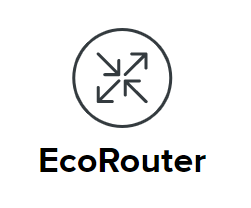 |
IP/MPLS Router on the EcoRouter platform
IP/MPLS routers designed to carry out critical functions in the networks of telecom operators at the levels of aggregation, distribution, core, network boundary (ASBR).
Part number:
Description
EcoRouter series routers are multi-purpose state-of-the art devices that support a wide range of technologies – both traditional IP routing and Multi-Protocol Label Switching (MPLS). The equipment can be used at all levels of telecom operators and corporate networks.
EcoRouter Devices:
developed using unified hardware components based on Intel integrated circuits;
mounted in a standard 19″ telecommunication rack;
have an optimal form factor from 1 RU to 2 RU;
low power consumption;
have a single operating system EcoRouterOS;
available in both fixed and modular versions, which allows you to choose the optimal configuration for solving the tasks of telecom operator.
EcoRouter throughput provides up to 320 Gbps per device and allows to work with large routing tables (up to 5 million routes in FIB).
EcoRouter series routers support the following functionality:
IPv4 unicast routing (Static, RIP, OSPFv2, IS-IS, MP-BGP);
IPv4 multicast routing (IGMPv1/v2/v3, PIM-DM / SM / SSM);
MPLS traffic switching;
LDP / Targeted LDP;
MPLS L3 VPN implementation;
Pseudowire MPLS technology with the support of the Pseudowire Redundancy mechanism;
VPLS (LDP-based) support;
Flexible mechanisms for manipulating VLAN tags on Ethernet interfaces (push/pop/swap);
DHCP Relay and DHCP Proxy operation modes;
IP traffic tunneling using GRE and IP-in-IP encapsulation;
VRRP redundancy protocol;
Hierarchical Quality of Service (H-QoS);
Safety functions (L3/L4 ACL, CoPP, etc.);
SSH and Telnet management with authentication using TACACS+ and RADIUS servers;
SNMP v1/2/3, SNMP Trap and Syslog support for integration with monitoring and statistics collection systems;
Container virtualization technology.
A large set of functions, the possibility of combining L2 and L3 services, support for MPLS technologies – all these allow telecom operators and enterprises to simplify the architecture of their network, as well as to improve the quality and reliability of services provisioning. At the same time, a significant reduction in both capital and operational costs for network maintenance and operation is ensured.
The built-in virtualization technology makes it possible to run arbitrary third-party applications on the same device and deploy additional network services: AntiVirus / AntiSpam, IDS / IPS, and creation of secure tunnels using IPsec encryption or GOST 28147–89. Such functions increase the safety of nodes, making the services of telecom operators more attractive to subscribers. Owners of corporate networks are able to reduce costs by using a minimum set of equipment when creating communication nodes in branches.
EcoRouter Devices:
developed using unified hardware components based on Intel integrated circuits;
mounted in a standard 19″ telecommunication rack;
have an optimal form factor from 1 RU to 2 RU;
low power consumption;
have a single operating system EcoRouterOS;
available in both fixed and modular versions, which allows you to choose the optimal configuration for solving the tasks of telecom operator.
EcoRouter throughput provides up to 320 Gbps per device and allows to work with large routing tables (up to 5 million routes in FIB).
EcoRouter series routers support the following functionality:
IPv4 unicast routing (Static, RIP, OSPFv2, IS-IS, MP-BGP);
IPv4 multicast routing (IGMPv1/v2/v3, PIM-DM / SM / SSM);
MPLS traffic switching;
LDP / Targeted LDP;
MPLS L3 VPN implementation;
Pseudowire MPLS technology with the support of the Pseudowire Redundancy mechanism;
VPLS (LDP-based) support;
Flexible mechanisms for manipulating VLAN tags on Ethernet interfaces (push/pop/swap);
DHCP Relay and DHCP Proxy operation modes;
IP traffic tunneling using GRE and IP-in-IP encapsulation;
VRRP redundancy protocol;
Hierarchical Quality of Service (H-QoS);
Safety functions (L3/L4 ACL, CoPP, etc.);
SSH and Telnet management with authentication using TACACS+ and RADIUS servers;
SNMP v1/2/3, SNMP Trap and Syslog support for integration with monitoring and statistics collection systems;
Container virtualization technology.
A large set of functions, the possibility of combining L2 and L3 services, support for MPLS technologies – all these allow telecom operators and enterprises to simplify the architecture of their network, as well as to improve the quality and reliability of services provisioning. At the same time, a significant reduction in both capital and operational costs for network maintenance and operation is ensured.
The built-in virtualization technology makes it possible to run arbitrary third-party applications on the same device and deploy additional network services: AntiVirus / AntiSpam, IDS / IPS, and creation of secure tunnels using IPsec encryption or GOST 28147–89. Such functions increase the safety of nodes, making the services of telecom operators more attractive to subscribers. Owners of corporate networks are able to reduce costs by using a minimum set of equipment when creating communication nodes in branches.